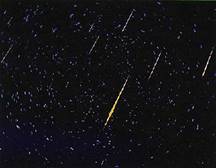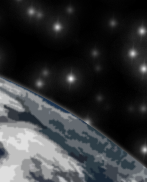|

http://static.howstuffworks.com/gif/leonid-meteor.jpg
Meteoroid
-
solid object moving in interplanetary space, of a size considerably smaller than an asteroid and considerably larger than an atom
-
remains of comets or asteroid that suffered collisions and are waving in space;
-
it is a peace of rock that enter into a collision course with Earth;
-
it is a body that wave in space, before colliding with the atmosphere.
Meteor
-
objects smaller than asteroids that collide with Earth;
-
particles of dust and rock that are flying through space at high speed
-
Appear to be large but in most cases, are just a granule of sand.
-
“Shooting star" is the popular name of the meteor in Brazil.
Meteor Rain
-
It occurs when the Earth passes through a region of its orbit where a comet has left a trail of dust;
-
Does not represent any risk for us;
-
Its name comes from its radiant-points.
Classification of Meteors
-
Litometeors: they are made of solid particles ;
-
Hidrometeors: make up with water in solid or liquid ;
-
Eletrometeors: representing optical or acoustic phenomena resulting from atmospheric electricity ;
-
Fotometeoros: optical phenomena , originated from the refraction and interference of light radiation emitted by the sun or the moon, like the rainbow twilight and the rays.
Meteorite
-
Fragments of extraterrestrial objects that came to the surface of the Earth;
-
A meteorite is a portion of a meteoroid or asteroid that survives its passage through the atmosphere and impact with the ground without being destroyed.
|

